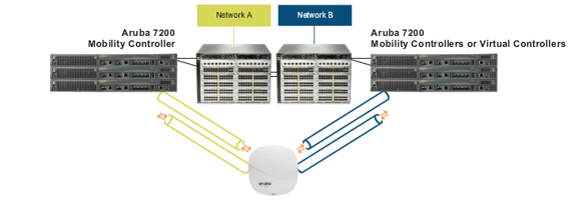EMAIL SUPPORT
dclessons@dclessons.comLOCATION
USAruba OS
Aruba OS
Customers might need multiple mobility controllers to provide redundancy or to support a multi-site environment. ArubaOS 8.0 and above offers a highly scalable architecture with the centralized Mobility Master (MM). The Mobility Master is sold as either hardware or a virtual appliance and manages all of the Mobility Controllers (MCs) and handles all configuration centrally. It also enables the MCs to use clustering for high availability.
The Mobility Master with ArubaOS is best for customers whose networks require automation and simplification for high densities.
ArubaOS architecture provides lowered downtime with high availability, automation and a better user experience, simplified operations, and enhanced security. ArubaOS 8.0 and above is the platform for the next generation of Aps including APs for 802.11ax.
The Aruba Mobility Master adds to this future-proofing with centralized management, real time upgrades, and north bound APIs for developers.
Aruba OS Benefits:
High Availability:
Customers in healthcare, manufacturing, higher education, and many other industries need to ensure their network is always on for mission-critical applications or 24/7 operation. The average Fortune 500 companies experiences 1.6 hours of downtime every week, and the total cost of network downtime for these companies can be as high as $164 million US dollars per year. Aruba helps customers achieve the high availability they need with controller clustering and Network uptime during upgrades.
Controller clustering ensures service continuity for failover events. Clustered controllers save client information for each controller in the cluster so that if one goes down, connections do not need to be reestablished. Having saved client information on each controller also improves user experience with seamless roaming and automated load-balancing for both the user and AP. Load balancing also improves scalability by efficiently using the capacity of each controller in the cluster.
Customers also get high availability by eliminating downtime on the network when updating the operating systems with live upgrades. In-service upgrades make it possible to patch or upgrade services without having to upgrade the OS. And gradual upgrades are for multiple OS on the same network.
Automation:
ArubaOS also improves user experience with RF optimization and automation.
With the Mobility Master, you can offer customers a more centralized and sophisticated version of ClientMatch as well as AirMatch: the evolution of ARM.
AirMatch brings automation to RF optimization. While ARM worked well for each AP, AirMatch enhances user experience in large, dense environments. AirMatch sends all the AP information to the Mobility Master, which has a centralized view of the network, more compute, and more memory power. The Mobility Master then creates an optimized RF plan with even channel assignment, dynamic Channel width adjustment and automated power planning for each AP.
Simplified Operation:
The Mobility Master provides one place to push down configuration to all controllers, so your customers can reduce the time it takes to configure a network from four to five hours to four to five minutes. It is
also easier to scale the network, and provisioning APs and wireless networks only take a few steps thanks to a modern and simple user interface. With centralized licensing, all licenses are hosted from one location with optional segmentation.
For customers who want to improve network intelligence with the ability to innovate within their network, ArubaOS also offers northbound APIs for developers.
Enhanced Network Security
ArubaOS also enhances security with MultiZone and Dynamic Segmentation.
For customers who want to secure multiple separate networks under one access point, Aruba offers MultiZone. This secure data separation is useful for governments, universities, shopping malls, and service providers who need different groups to have their own networks in the same physical space.
While the Mobility Master is not necessary for this feature, two controllers are needed. Customers can also unify policy control across wired and wireless networks with dynamic segmentation. This feature allows administrators to provide consistent polices on all traffic once it is inside the network. Tunnels send wired traffic to the controller for enhanced security.





LEAVE A COMMENT
Please login here to comment.